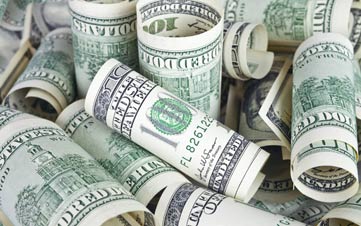8 Best Dividend Funds for Retirees
Just how important are stock dividends?


Just how important are stock dividends? Over the long haul, these cash payouts have accounted for some 40% of overall U.S. market returns. In periods of poor stock market performance, they’ve played an even larger role in returns. For that reason, we set out to find the best dividend-oriented exchange-traded funds. As you’ll see, each ETF has its own strategy, tied to the particular index it tracks.
Disclaimer
Funds are listed in alphabetical order. All prices, returns, yields and portfolio data are through May 4.

ALPS Sector Dividend Dogs ETF
- Share price: $38.81Current yield: 3.8%Assets: $1.1 billionExpense ratio: 0.40%Top five holdings: Oneok, Baxter International, Cummins, Pfizer, Navient
- SEE ALSO: Vanguard ETFs vs. Vanguard Mutual Funds: Which Make for Better Investments?
Value investors will appreciate ALPS Sector Dividend Dogs ETF (SDOG).
It takes the Dogs of the Dow strategy, which invests in the 10 highest-yielding stocks in the Dow Jones industrial average, and applies it to the top yielders across the 10 sectors of Standard & Poor’s 500-stock index. The fund’s 49 stocks—representing the highest yielders in each sector – are equally weighted. So each stock represents roughly 2% of the ETF’s assets, and each sector, 10%. From the ETF’s launch in June 2012, it returned 15.7% annualized, outpacing the returns of two of the most popular dividend ETFs, Vanguard Dividend Appreciation ETF (VIG) and iShares Select Dividend ETF (DVY), by an average of 3.6 and 1.8 percentage points per year, respectively. The S&P 500 returned 13.6% annualized over that same period.

iShares Select Dividend Index ETF
- Share price: $81.69Current yield: 3.2%Assets: $14.6 billionExpense ratio: 0.39%Top five holdings: Lockheed Martin, CME Group, Chevron, Philip Morris International, McDonald's
This ETF follows a Dow Jones benchmark that includes 95% of publicly traded U.S. stocks (excluding real estate investment trusts) that have maintained or increased dividends over the past five years. iShares Select Dividend Index (DVY) is heavy in utilities, with 30% of its assets in the sector. Over the past five years, Select Dividend Index returned 12.7% annualized, beating the S&P 500 by an average of 1.6 percentage points per year. Over that period, the ETF was about 18.5% less volatile than the index, too.

Schwab U.S. Dividend Equity ETF
- Share price: $39.90Current yield: 3.1%Assets: $3.4 billionExpense ratio: 0.07%Top five holdings: Pfizer, Chevron, ExxonMobil, Johnson & Johnson, PepsiCo
With its minuscule expense ratio, Schwab U.S. Dividend Equity ETF (SCHD) is the cheapest of all the funds highlighted in this feature.
To be eligible for this ETF, a company must have paid dividends every year for at least 10 years and must boast a market capitalization of at least $500 million. A company must be financially strong, too, based on four measures, such as return on equity (a measure of profitability) and five-year dividend growth rate. Finally, only stocks with significant trading volume qualify. U.S. Dividend Equity, a member of the Kiplinger ETF 20, the list of our favorite ETFs, launched in October 2011. Since then, the fund returned 14% annualized. That trails the 14.7% annualized return in the S&P 500. The fund has done well so far this year, climbing 4.3%, thanks in part to Chevron and ExxonMobil, which notched 13% and 13.6% gains, respectively.

SPDR S&P Dividend ETF
- Share price: $80.72Current yield: 2.4%Assets: $13.5 billionExpense ratio: 0.35%Top five holdings: HCP, AT&T, Chevron, Old Republic International, AbbVie
- SPDR S&P Dividend (SDY) isn’t just for snobs, despite the snooty-sounding name of the index it tracks: S&P High Yield Dividend Aristocrats.
- SEE ALSO: Income Investing: Why I Stand by Muni Bonds
The moniker makes sense when you find out what membership requires. Out of the S&P Composite 1500 index, which represents 90% of all publicly traded U.S. companies, only those firms that have raised their dividend without pause in each of the past 20 years are permitted entry. This requirement tilts the index—and thus, the ETF—toward growing, high-quality firms. The fund holds 107 stocks and weights them by dividend yield. This is the fund to own in down markets. In 2008, when the S&P 500 plummeted 37.0%, S&P Dividend ETF dropped 23.1%. During the 2011 correction, when the S&P 500 lost 18.6%, this ETF held up better, slipping 13.6%.

Vanguard Dividend Appreciation ETF
- Share price: $81.11Current yield: 2.2%Assets: $20.7 billionExpense ratio: 0.10%Top five holdings: Microsoft, Coca-Cola, Johnson & Johnson, PepsiCo, CVS Health
- TAKE THE QUIZ: How Well Do You Know Your Dividends?
This low-cost ETF is the biggest one on our list. Like SPDR S&P Dividend, Vanguard Dividend Appreciation ETF (VIG) focuses on companies that raise their dividends, not stocks with high yields. Only U.S. companies that have increased their dividends every year for at least the past 10 years make it into the fund (the fund excludes REITs and master limited partnerships).
Today, 186 stocks make the grade. Because of the fund’s requirements, consumer stocks and industrials make up almost half of the fund’s assets. Interestingly, financial firms account for only 8% of assets, a legacy of the financial crisis, which forced many banks to cut dividends or, at best, stop raising them. The fund’s 10-year annualized return of 7.1% narrowly beats the 6.8% average yearly gain of the S&P 500.

Vanguard High Dividend Yield ETF
- Share price: $69.05Current yield: 3.2%Assets: $13.4 billionExpense ratio: 0.09%Top five holdings: Microsoft, ExxonMobil, General Electric, Johnson & Johnson, Wells Fargo
- SEE ALSO: 6 Great Dividend Stocks for Retirees
At first glance, Vanguard High Dividend Yield ETF (VYM) may seem awfully similar to Vanguard Dividend Appreciation. The two ETFs charge roughly the same fees and share the same top holding, Microsoft. But High Dividend Yield holds 480 stocks, more than double the number in Dividend Appreciation. And its yield is a percentage point higher.
With this ETF, yield matters most. The stock-picking process starts by looking at U.S. companies (excluding REITs and MLPs) that are expected to pay a dividend over the next 12 months and then takes the highest-yielding stocks and weights them by market value. The result is a portfolio of large-company stocks with a value tilt. High Yield Dividend outpaced the S&P 500 over the past five years with an annualized return of 12% and did so with less volatility than the index.

WisdomTree MidCap Dividend ETF
- Share price: 86.27Current yield: 2.9%Assets: $1.7 billionExpense ratio: 0.38%Top five holdings: Oneok, Mattel, Frontier Communications, Centerpoint Energy, Coach
WisdomTree creates a proprietary index for each of its ETFs. Its so-called smart-beta, or enhanced, index funds tweak the traditional formula of indexing—weighting a basket of stocks by market value—by using other factors to determine a stock’s importance in an index.
As its name suggests, WisdomTree MidCap Dividend (DON) focuses on midsize dividend-paying U.S. firms—the index it tracks includes firms with market values of between $600 million and $13 billion. But MidCap Dividend weights its 400 stocks by the dollar amount each company is expected to pay out over the coming year. Over the past five years, the fund returned 12.4% annualized, beating iShares Russell Mid-Cap ETF (IWR), a traditional, capitalization-weighted fund, by an average of 2.4 percentage points per year. The WisdomTree ETF was less volatile to boot.

WisdomTree SmallCap Dividend ETF
- Share price: $69.73Current yield: 3.9%Assets: $1.3 billionExpense ratio: 0.38%Top five holdings: Targa Resources, Cal-Maine Foods, Covanta Holding, Innoviva, Regal Entertainment Group
- SEE ALSO: 11 Great Dividend Stocks for Income Investors
Like its mid-cap sibling, WisdomTree SmallCap Dividend (DES) tracks a proprietary index of dividend-paying stocks. In this instance, though, the focus is on small companies—defined in this case as firms with market caps of less than $3.5 billion . The fund weights its 700-plus holdings by the size of the dividend each company is expected to pay in the coming year.
SmallCap Dividend has delivered more bang with less angst than its traditional index counterpart, iShares Russell 2000 ETF (IWM). Over the past five years, SmallCap Dividend returned 11.1% annualized, outpacing the iShares ETF by an average of 3.6 percentage points per year. Over that period, the WisdomTree ETF was 12.4% less volatile than the iShares fund.
Get Kiplinger Today newsletter — free
Profit and prosper with the best of Kiplinger's advice on investing, taxes, retirement, personal finance and much more. Delivered daily. Enter your email in the box and click Sign Me Up.

Nellie joined Kiplinger in August 2011 after a seven-year stint in Hong Kong. There, she worked for the Wall Street Journal Asia, where as lifestyle editor, she launched and edited Scene Asia, an online guide to food, wine, entertainment and the arts in Asia. Prior to that, she was an editor at Weekend Journal, the Friday lifestyle section of the Wall Street Journal Asia. Kiplinger isn't Nellie's first foray into personal finance: She has also worked at SmartMoney (rising from fact-checker to senior writer), and she was a senior editor at Money.
-
 Vaccines Medicare Covers for Free
Vaccines Medicare Covers for FreeThe U.S. is experiencing an outbreak of measles and is on track to have the most whooping cough cases since 1948; these vaccines Medicare covers for free can keep you safe.
By Donna LeValley
-
 Why You Need a Trusted Contact for Your Brokerage
Why You Need a Trusted Contact for Your BrokerageYour brokerage or bank needs someone to reach out to if it's concerned you're experiencing fraud or cognitive decline. That's where a trusted contact can help.
By John Waggoner
-
 Stock Market Today: No 'Powell Put'? No Problem
Stock Market Today: No 'Powell Put'? No ProblemInvestors, traders and speculators look beyond both another Trump post and more signs of slowing economic activity.
By David Dittman
-
 Stock Market Today: Dow Drops 699 Points After Powell Speech
Stock Market Today: Dow Drops 699 Points After Powell SpeechFed Chair Powell warned of a slowing economy and higher inflation but said the central bank isn't ready to cut rates just yet.
By Karee Venema
-
 Stock Market Today: Stocks Struggle Amid Tariff Uncertainty
Stock Market Today: Stocks Struggle Amid Tariff UncertaintyBoeing dropped after China suspended new aircraft orders, while Bank of America and Citi climbed on earnings beats.
By Karee Venema
-
 Stock Market Today: Stocks Gain on Tech, Auto Tariff Talk
Stock Market Today: Stocks Gain on Tech, Auto Tariff TalkThe Trump administration said late Friday that it will temporarily halt tariffs on some Chinese tech imports.
By Karee Venema
-
 Stock Market Today: Stocks Surge to Close a Volatile Week
Stock Market Today: Stocks Surge to Close a Volatile WeekIt was another day with a week's worth of both news and price action, but it ended on a strongly positive note.
By David Dittman
-
 Stock Market Today: Uncertainty Proliferates: Dow Loses 1,014 Points
Stock Market Today: Uncertainty Proliferates: Dow Loses 1,014 PointsWeaker-than-expected consumer inflation data wasn't enough to stabilize sentiment during another volatile day for financial markets.
By David Dittman
-
 Stock Market Today: Tariff Pause Triggers 3,000-Point Dow Rally
Stock Market Today: Tariff Pause Triggers 3,000-Point Dow RallyThe bond market is sending concerning signals as the Trump administration executes its rapid reordering of global trade relationships.
By David Dittman
-
 Stock Market Today: Tariff Talks Drive Another Up-and-Down Day
Stock Market Today: Tariff Talks Drive Another Up-and-Down DayTrade war negotiations are happening, but the "fear gauge" is gyrating, and investors, traders and speculators are still searching for signs of a bottom.
By David Dittman
